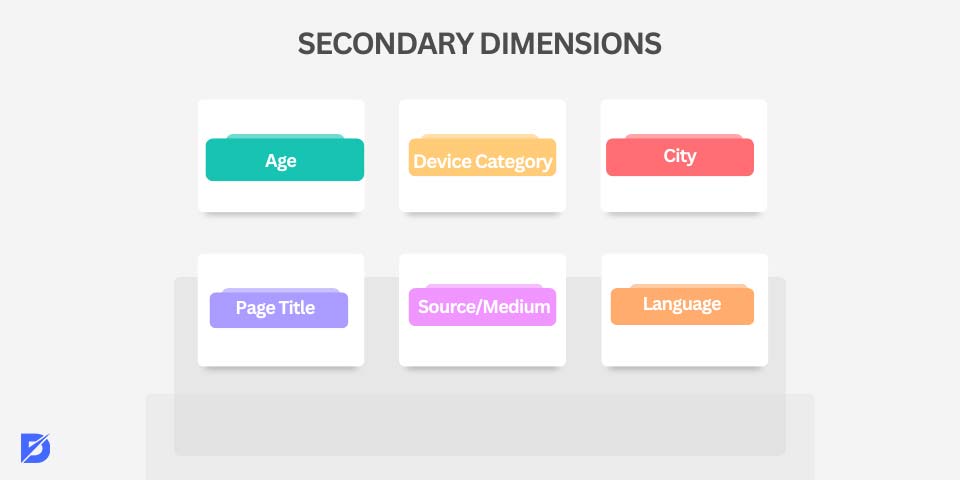Transform Your Data Comprehending With Second Measurements
Discovering information with the lens of secondary measurements opens up a realm of untapped insights, providing a more nuanced viewpoint on the details of your dataset. By untangling the layers underneath the surface metrics, you can uncover patterns and relationships that might have otherwise gone undetected, leading the way for notified decision-making and strategic optimizations. This strategic application of additional measurements not only enhances your information comprehension but also functions as a catalyst for opening the complete capacity of your analytics endeavors.
Advantages of Additional Dimensions

Second measurements additionally allow services to perform more comprehensive efficiency analyses. By layering additional dimensions onto existing information, companies can examine the influence of various aspects on vital metrics, aiding them make more informed choices. Additionally, second dimensions promote the recognition of brand-new possibilities for optimization and growth by uncovering relationships that might have otherwise gone unnoticed. On the whole, the use of second measurements causes a lot more durable and insightful information evaluation, encouraging organizations to drive critical activities based upon a deeper understanding of their data.

How to Carry Out Second Measurements
To properly implement secondary measurements in information evaluation, companies ought to first recognize crucial variables that align with their analytical objectives and purposes. It is essential to take into consideration just how these additional dimensions will provide added context and deepness to the key information being evaluated.

Studying Data With Secondary Measurements
Utilizing secondary measurements in information analysis enhances the deepness and context of understandings stemmed from main data. By incorporating second dimensions into your evaluation, you can obtain a more thorough understanding of the connections and patterns within your data. This procedure involves analyzing the key information through various lenses or point of views, which can reveal hidden connections or patterns that might not be immediately noticeable when evaluating the information utilizing only key measurements.
Examining data with second dimensions permits you to section and group your data in numerous ways, giving a much more nuanced sight of your dataset. secondary dimensions. This segmentation can aid you determine certain elements that might be influencing the end results you are examining. By piercing down into the information using additional measurements, you can uncover beneficial insights that can assist decision-making and method development
Finest Practices for Second Dimensions
When including second dimensions into data analysis, precision in specifying the measurements is essential for drawing out purposeful insights. It is crucial to choose additional dimensions that match the primary data successfully.
An additional ideal practice is to avoid redundancy in dimensions. Make sure that the additional measurements include new point of views or details to the analysis, instead of duplicating information already present in the primary dimensions. This will certainly find more info help stop complication and enhance the analysis of the data.
In addition, it is necessary to take into consideration the scalability of the evaluation when choosing additional dimensions. Choose measurements that can be from this source conveniently broadened or changed as needed to fit future information needs or adjustments in analytical focus. By adhering to these ideal techniques, experts can maximize the worth of additional dimensions in information evaluation and gain deeper insights into their datasets.
Optimizing Insights With Secondary Measurements
Integrating secondary measurements tactically improves data evaluation by giving a much deeper understanding of the relationships within the dataset (secondary dimensions). By maximizing understandings via secondary measurements, analysts can reveal useful patterns, trends, and dependences that may not be instantly apparent when checking out the data through key dimensions alone
One key advantage of using secondary measurements is the ability to section and filter information a lot more precisely. This segmentation enables a much more granular evaluation of certain parts within the dataset, allowing experts to recognize relationships and causations that might have or else been overlooked.
In addition, additional measurements can help in contextualizing key data points by adding layers of information that supply a more thorough sight of the information. This contextualization is crucial for making informed choices based on a holistic understanding of the dataset.
Verdict
Finally, including secondary dimensions in data evaluation processes supplies a much more comprehensive and nuanced understanding of info, bring about enhanced insights and strategic decision-making. By integrating extra variables that straighten with logical objectives, concealed correlations and trends can be revealed, offering a much more in-depth and contextualized sight of information. This technique takes full advantage of the possibility for optimization and reveals brand-new possibilities within procedures.
On the whole, the application of second dimensions leads to much more insightful and robust information evaluation, encouraging services to drive critical company website activities based on a much deeper understanding of their data.
Using secondary dimensions in information evaluation enhances the deepness and context of understandings acquired from main data.Evaluating data with second measurements permits you to section and group your information in numerous methods, supplying a much more nuanced view of your dataset.When including secondary measurements into data evaluation, accuracy in defining the dimensions is vital for drawing out meaningful understandings. Make certain that the additional dimensions add brand-new viewpoints or details to the evaluation, instead than duplicating details already present in the key measurements.